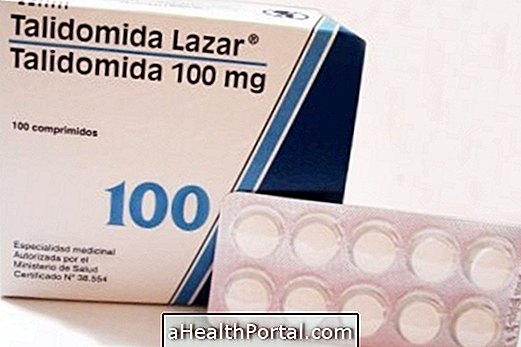Plantar fasciitis is an inflammation of a flat connective tissue found in the sole of the foot, called fascia, which generates symptoms such as pain in the sole of the foot, burning sensation and discomfort when walking and running. Often overweight women who wear high heels daily are the most affected.
The treatment is slow and can last about 1 year to 18 months but it is important to decrease the pain and improve the quality of life of the person. Some options are analgesics, anti-inflammatories and physiotherapy that can be done with devices like ultrasound and shock waves, for example.

Symptoms
The most characteristic symptom of plantar fasciitis is pain in the middle of the heel when stepping on the floor on the floor shortly after waking, but other symptoms that may be present are:
- Pain in the sole of the foot that gets worse when wearing high heels or running;
- Feeling of burning in the sole of the foot;
- Sensation of 'sand' when pressing the place where the fascia is.
The symptoms are related to the thickening of the fascia due to inflammation and the presence of fibrosis and calcification in this tissue. The diagnosis can be made by the orthopedist or physiotherapist, taking into account only the symptoms and performing specific tests that cause pain in the affected area.
Exams such as x-rays do not directly evidence fasciitis but may be helpful in ruling out other diseases.
Causes
The causes of plantar fasciitis can be related to long walks with the use of very hard shoes and may be related to the fact that the foot of the individual is very cavo and of being overweight. The combination of these factors may contribute to the inflammation of this tissue, which if left untreated can cause intense pain, making daily activities difficult.
The spur of the heel may be present, as well as the imprisonment syndrome involving the nerves of the foot. The use of high heels continuously leads to decreased mobility of the Achilles tendon, which also favors fasciitis.
Treatment for plantar fasciitis
Treatment for plantar fasciitis can be done with the use of anti-inflammatories, under the indication of the orthopedist, and physiotherapy, where the goal will be to deflate the region, improving blood circulation and undoing the nodules formed in the tendons, if any.
Other helpful tips for treating plantar fasciitis can be:
- Apply an ice pack for 15 minutes on the soles of the feet, about 2 times a day;
- Use an insole indicated by the orthopedist or physiotherapist;
- Do a "leg potato" foot and muscle stretching, staying under a slightly sloping surface, such as climbing a ramp, for example. Stretching is well done when you sit the "potato" of the stretching leg. This positioning should be maintained for at least 1 minute, 3 to 4 times in a row.
- Wear comfortable shoes that properly support the feet, avoiding the use of hard shoes.
This injury is very common in runners due to the use of sneakers that is not suitable for running or for prolonged use of running shoes for a long time. It is usually recommended to use running shoes for only 600 km and should be changed after this period, however, it is possible to use these sneakers for the day to day, being only contraindicated in training and running tests.























